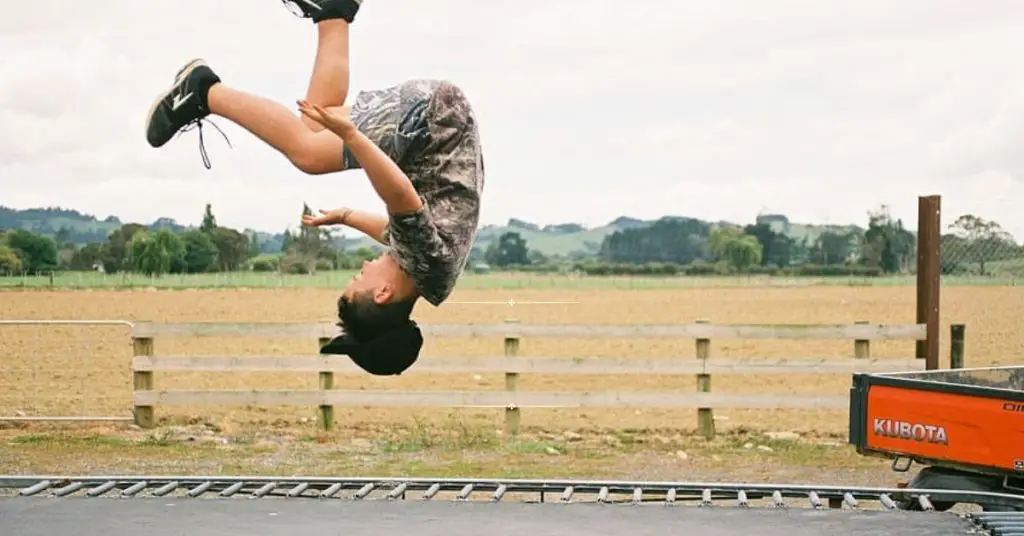Having a trampoline in my yard brings so much excitement. It’s not only a fantastic source of fun but also a great way to stay active and relieve stress. Whenever I gather with friends and family, the trampoline becomes the center of attention and sparks lively conversations.
As I’ve been increasing my trampoline jumping, a thought has crossed my mind: Is Jumping on a Trampoline Bad for Scoliosis? I’ve wondered if the act of bouncing on a trampoline could contribute to the curvature of my spine.
It’s important to note that individuals who already have scoliosis may experience an accelerated progression of their spine curvatures when using a trampoline. However, if I don’t have scoliosis, I can rest assured that this enjoyable activity won’t cause the development of the condition.
It’s always crucial to prioritize my spinal health and seek professional advice, especially if I have scoliosis, to ensure I’m engaging in trampoline jumping safely. So, I can continue to enjoy the thrills of trampolining without worrying about any negative impact on my spine.
Is Jumping on a Trampoline Bad for Scoliosis: Jumping on a trampoline can potentially accelerate the progression of spine curvatures in individuals with scoliosis. Consult a healthcare professional for personalized advice on trampoline use with scoliosis.
Is Jumping on a Trampoline Bad for Scoliosis?

Yes, if someone has severe scoliosis, it is generally advised to avoid trampolining. Several organizations, such as the National Scoliosis Foundation and the London Orthotic Consultancy, have recommended against trampolining for individuals with scoliosis.
What are recommended Exercises for Individuals with Scoliosis?
If trampolining isn’t suitable for individuals with scoliosis, what types of exercises are beneficial for them? According to the London Orthotic Consultancy, it is recommended to engage in weight-bearing exercises that apply gentle pressure on the spine, gradually strengthening it.
They also suggest standing exercises that serve the same purpose. Some examples of these exercises may include:
When it comes to exercises for scoliosis, activities like netball, basketball, and rock climbing can help strengthen the extensor muscles that support our posture against gravity.
Yoga, Pilates, and gymnastics are great for improving core strength and flexibility, which are beneficial for people with scoliosis.
However, it’s important to note that these exercises are generally recommended for individuals with mild scoliosis. If someone has a more severe form of scoliosis, certain exercises may cause discomfort.
In such cases, focusing on exercises that strengthen core muscles, improve posture, and reduce pain and fatigue can still be beneficial. This often includes yoga, gymnastics, and Pilates, with specific exercises like pelvic tilts, sitting rotation stretches, cat/cow yoga stretches, bird/dog yoga stretches, and planking.
If someone is unsure about which exercises are suitable for their scoliosis, it’s a good idea to do some research or consult their doctor or a physiotherapist.
Physiotherapy often involves personalized exercise programs that consider factors such as the individual’s specific needs, posture, flexibility level, age, pain level, and exercise tolerance.
A skilled physiotherapist can design and guide a person through an exercise routine that caters to their condition and helps them manage their scoliosis effectively.
What Sports Should Individuals with Scoliosis Avoid?
Individuals with scoliosis need to be cautious about participating in certain sports as they can negatively affect their condition, despite the benefits of exercise. Trampolining, in particular, is considered one of the worst exercises for those with scoliosis.
It increases the force of gravity on the spine, further compressing an already curved spine and worsening the condition.
While most other exercises are not as problematic and may be recommended in moderation or avoided due to limited benefits, there are a few worth mentioning.
Swimming may not provide significant benefits for scoliosis due to its low weight-based exercise nature unless specific exercises targeting the rib cage are incorporated.
Sports involving prolonged sitting, such as cycling and rowing, may compress the spine and should be approached with caution. Weightlifting, especially deadlifting, and exercises like squats, lunges, and hamstring curls can exert considerable pressure on the spine and are best avoided.
Activities involving repeated torso extensions, such as ballet, dancing, high jumps, and backbends, pose a risk of aggravating scoliosis and should be steered clear of. Extreme yoga poses should also be approached with care, as they can worsen the condition.
Contact sports like American football, martial arts, and boxing carry a high risk of putting significant stress on the spine through hits or tackles, potentially worsening scoliosis, especially if the person has undergone surgery.
What is the Precise Definition of Scoliosis?
For those who are unfamiliar, scoliosis refers to an abnormal curvature of the spine. Normally, the spine curves gently in an “S” shape, but in scoliosis, the curve is irregular. This condition can cause various symptoms, including:
- Noticeable abnormal curvature
- Shoulders appearing uneven
- Leaning to one side
- Ribs protruding on one side
- Clothes not fitting properly
Around 80% of scoliosis cases have an unknown cause, referred to as idiopathic scoliosis. It cannot be prevented and is not believed to be linked to exercise or diet.
However, scoliosis can also be caused by congenital factors, underlying nerve or muscle conditions like muscular dystrophy cerebral palsy, or natural degeneration with age.
In most cases, scoliosis is not painful and does not require treatment or surgery. People with scoliosis are generally encouraged to engage in exercise unless advised otherwise by their doctors.
However, individuals with moderate to severe scoliosis may experience back pain and fatigue, which can make exercising more challenging.
Can Trampolines Contribute to the Development of Back Problems?
If you are in good health, trampolines are generally safe for your back. Jumping on a trampoline can help strengthen the muscles around your spine and improve overall fitness.
However, if you already have back problems, jumping on a trampoline can be problematic. Conditions like scoliosis, herniated discs, and degenerative disc issues can be worsened by trampoline jumping.
On the other hand, if you have a healthy back, trampolining is considered a low-risk exercise. Over time, it can strengthen your back muscles and alleviate strain on the spine, unlike more intense workouts.
Remember, it’s always important to listen to your body and consult with a healthcare professional if you have any concerns or existing back issues before engaging in trampoline activities.
Does a Trampoline have Positive Effects on the Spine?

If you have a healthy spine, trampoline rebounding can be highly beneficial. It is a safe and low-impact exercise that reduces pressure on the bones and muscles surrounding the spine.
Trampolining is similar to swimming in terms of being gentle on the body.
Engaging in trampoline activities offers several advantages for the spine, such as improved back flexibility, strengthened muscles in the lower back, stimulation of internal organs, and enhanced shock absorption capabilities.
Overall, trampolining can contribute positively to the health of your spine.
However, if you have specific injuries like herniated discs, pinched nerves, osteoporosis, or similar back problems, it is best to avoid trampolining. These conditions may not benefit from this type of exercise and could potentially worsen over time.
It’s important to prioritize your safety and consult with a healthcare professional regarding suitable exercises for your specific back injuries.
What are the Consequences of Prolonged Trampoline Jumping?
What happens if you jump on a trampoline for an extended period? Well, similar to any exercise, excessive trampoline jumping can have negative effects on your body.
Spending too much time on a mini trampoline can strain your muscles, especially if you push yourself too hard. Additionally, the repetitive impact of landing can put stress on your joints, causing discomfort or injury.
It’s important to note that mini trampolines, which are closer to the ground, don’t allow for complex flips or risky maneuvers like larger trampolines. If you’re looking to minimize the risk of injury, opting for a mini trampoline is a safer choice.
To prevent overexertion, listen to your body and pay attention to how you feel after each session. Start with shorter workouts and gradually increase the duration based on your comfort level.
Ultimately, as long as you exercise in moderation, you can enjoy jumping on a trampoline for as long as you’d like!
What are the Effects of Daily Trampoline Jumping?
What happens when you jump on a trampoline every day? Well, if you make it a daily habit, there are several positive outcomes you can expect over time.
Here are some things that may happen when you jump on a trampoline regularly:
- Building muscles: Jumping on a trampoline can help strengthen your muscles.
- Burning fat: It can contribute to burning calories and reducing body fat.
- Improved agility and balance: Regular trampolining can enhance your coordination and balance skills.
- Strengthened hips, stomach, arms, and legs: The jumping motion engages and strengthens various muscles in these areas.
- Improved cardiovascular strength: Jumping on a trampoline provides a good cardiovascular workout, benefiting your heart health.
If you’re new to trampolining, it’s a good idea to start with short sessions of 5-10 minutes per day. As you become more comfortable, you can gradually increase the duration of your jumping sessions. Remember, exercising on a trampoline can be both beneficial and enjoyable at the same time!
Are Trampolines Harmful to Your Hips?
Does jumping on a trampoline have negative effects on your hips? Well, there is conflicting information on this matter.
Some people believe that trampolining can be beneficial for your hip flexors, while others think it may cause stiffness due to the impact. The impact of jumping can vary from person to person.
To understand the true impact of trampolining on the hips, further research is needed. Hip problems can be significant and can affect your mobility as you age. It’s important to gather more information before engaging in trampolining to make an informed decision.
How often should I Trampoline Per Week?
Well, even just 5-19 minutes of trampolining 3-5 times a week can be sufficient. You can get a more intense workout in a shorter amount of time on the trampoline.
As you become more comfortable, you can increase the duration of your trampolining sessions. It’s important to listen to your body and be aware of your limits. There is a point where too much trampolining can be detrimental, so it’s crucial to avoid exceeding that limit.
You have the flexibility to decide how frequently you want to trampoline. It’s a fantastic and versatile exercise that can be tailored to your preferences and needs.
Benefits of Trampoline Jumping

Trampoline jumping offers numerous benefits for physical health and overall well-being. Here are the key advantages in more detail:
Cardiovascular Fitness:
Jumping on a trampoline is a form of aerobic exercise that increases heart rate and improves cardiovascular endurance. It gets your heart pumping, leading to better circulation and overall cardiovascular health.
Improved Balance and Coordination:
Trampoline jumping requires you to maintain balance and coordination while bouncing. This constant adjustment and control improves your balance and coordination skills over time, which can be beneficial in daily activities and sports.
Muscle Strength and Bone Density:
The repetitive jumping motion on a trampoline engages various muscle groups, including the legs, core, and back. This helps strengthen and tone these muscles, leading to improved overall strength and muscle development.
Additionally, trampolining is a weight-bearing exercise, which can promote bone density and reduce the risk of osteoporosis.
Joint-Friendly Exercise:
Trampolines provide a low-impact workout, meaning they reduce stress on the joints compared to high-impact activities like running or jogging. This makes trampolining a suitable option for individuals with joint issues or those looking for a gentler form of exercise.
Enhanced Lymphatic System Function:
The up-and-down bouncing action of trampoline jumping stimulates the lymphatic system, which is responsible for removing toxins and waste from the body. This can help improve the body’s detoxification process and support a healthy immune system.
Stress Relief and Mood Enhancement:
Engaging in trampolining releases endorphins, which are the body’s natural feel-good hormones. These endorphins promote relaxation, reduce stress levels, and enhance mood, leaving you feeling happier and more relaxed after a trampoline session.
Increased Energy and Vitality:
Regular trampoline jumping can boost energy levels and overall vitality. The physical activity and increased oxygen intake during bouncing contribute to a sense of invigoration and increased energy throughout the day.
Enjoyable: Trampolining is a fun and playful activity that can make exercise more enjoyable. The feeling of weightlessness and the joy of bouncing can make it easier to stay motivated and consistent with your exercise routine.
It’s important to note that individual experiences may vary, and it’s always advisable to consult with a healthcare professional before starting any new exercise regimen, especially if you have pre-existing health conditions.
They can provide personalized guidance based on your specific needs and ensure that trampolining is safe and suitable for you.
Considerations for Individuals with Scoliosis
For individuals with scoliosis, there are some considerations to keep in mind when engaging in trampoline jumping or any other physical activity. Here are a few points to consider:
- Consult with a healthcare professional: Before starting any exercise routine, it’s important to consult with a healthcare professional, such as a doctor or physical therapist, who can assess your specific condition and provide guidance on what activities are safe for you.
- Individualized approach: Scoliosis varies in severity and type, so what works for one person may not be suitable for another. It’s crucial to have an individualized approach that takes into account the specific curvature of your spine and any other related factors.
- Avoid high-impact movements: Trampoline jumping involves impact on the spine, and individuals with scoliosis may experience increased discomfort or strain. It’s advisable to avoid high-impact movements, such as bouncing too vigorously or performing flips, as they can put additional stress on the spine.
- Maintain proper form and technique: When jumping on a trampoline, it’s important to focus on maintaining proper form and technique. This includes keeping your core engaged, landing softly on the trampoline mat, and avoiding excessive twisting or bending motions that may strain the spine.
- Gradual progression: Start with shorter sessions and gradually increase the duration and intensity of your trampoline workouts. This allows your body to adapt and helps you gauge how your spine responds to the activity.
- Listen to your body: Pay attention to any discomfort, pain, or increased curvature during or after trampoline jumping. If you experience any adverse effects, it’s essential to stop and consult with your healthcare professional.
- Supplement with other exercises: While trampolining can offer benefits, it’s important to complement it with exercises that specifically target posture, core strength, and flexibility. Your healthcare professional can recommend exercises tailored to your condition.
Remember, the information provided here is general, and it’s crucial to consult with a healthcare professional who can provide personalized advice based on your individual needs and the specific characteristics of your scoliosis.
Precautions and Recommendations

Here are some precautions and recommendations:
Consulting with a Healthcare Professional:
Individuals with scoliosis need to consult with a healthcare professional, such as a doctor or physical therapist, before engaging in any physical activity, including trampolining.
They can assess your specific condition, provide medical clearance, and offer guidance on what activities are safe and suitable for you.
Guidelines for Individuals with Scoliosis Using a Trampoline:
Here are guidelines for individuals with scoliosis using a trampoline:
Seek Medical Clearance and Guidance:
Before starting trampoline jumping, it is crucial to seek medical clearance from a healthcare professional who can assess your scoliosis and provide specific recommendations based on your condition. They can guide you on the appropriateness and safety of trampolining for your spine.
Start with Low-Impact Activities and Gradual Progression:
Begin with low-impact trampoline activities, such as gentle bouncing or controlled movements, to minimize stress on the spine. Gradually increase the intensity and duration of your trampoline sessions as tolerated, under the guidance of your healthcare professional.
Focus on Maintaining Proper Form and Posture:
When jumping on the trampoline, pay attention to your form and posture. Engage your core muscles, keep your back straight, and land softly on the trampoline mat to minimize impact on the spine. Avoid excessive twisting or bending motions that may strain your back.
Listen to Your Body:
It is crucial to listen to your body and pay attention to any pain or discomfort during or after trampolining. If you experience increased pain or discomfort, it is important to stop and consult with your healthcare professional.
They can provide further guidance and adjustments to your trampoline routine if needed.
Consider Alternative Exercises or Modifications:
If trampolining is not recommended or tolerated due to your scoliosis, discuss alternative exercises or modifications with your healthcare professional. They can recommend exercises that target posture, core strength, and flexibility while minimizing strain on the spine.
Remember, each person with scoliosis is unique, and the recommendations may vary depending on the severity and characteristics of your condition.
Working closely with a healthcare professional will ensure that you can engage in physical activities safely and effectively while managing your scoliosis.
Alternative Exercise Options
If trampolining is not suitable or recommended for individuals with scoliosis, there are alternative exercises that can provide similar benefits while minimizing stress on the spine. Here are some options to consider:
Swimming:

Swimming is a low-impact exercise that helps improve overall strength, flexibility, and cardiovascular fitness.
It is gentle on the joints and provides a supportive environment for individuals with scoliosis.
Consult with a swimming instructor or physical therapist to learn specific swimming techniques that can benefit your condition.
Yoga and Pilates:
Yoga and Pilates focus on improving flexibility, core strength, and posture. These exercises can help individuals with scoliosis improve spinal alignment, increase muscle balance, and enhance body awareness.
It is essential to work with a qualified instructor who has experience in working with individuals with scoliosis to ensure proper modifications and alignment cues.
Core-Strengthening Exercises:
Engaging in exercises that target the core muscles, such as planks, bridges, and gentle abdominal exercises, can help stabilize the spine and improve posture.
These exercises should be performed under the guidance of a healthcare professional or physical therapist who can provide appropriate modifications based on your scoliosis.
Low-Impact Aerobics:
Participating in low-impact aerobic exercises, such as walking, cycling, or using an elliptical machine, can help improve cardiovascular fitness without placing excessive stress on the spine. It is important to maintain proper form and avoid any activities that cause discomfort or pain.
Resistance Training:
Incorporating resistance training exercises using light weights, resistance bands, or body weight can help strengthen muscles, including the core, back, and limbs.
However, it is crucial to work with a qualified trainer or physical therapist who can guide you in performing exercises that are safe and suitable for your scoliosis.
Remember, it is essential to consult with a healthcare professional, such as a doctor or physical therapist, to determine which alternative exercises are most appropriate for your specific condition.
They can provide personalized recommendations and modifications to ensure your safety and maximize the benefits of your exercise routine.
FAQs:
Q:1 Can trampoline jumping lead to the development of scoliosis?
Activities that involve bending your back, such as backbends, gymnastics, high jumps, dance moves (especially in ballet), and specific yoga poses, can make scoliosis worse.
These movements put pressure on the spine and cause the vertebrae to rotate further into the curve, leading to faster progression of scoliosis.
Q:2 Does jumping on a trampoline have negative effects on the spine?
When you jump on a trampoline, your body automatically tightens the muscles in your back to protect your spine. However, if you have herniated discs or degenerative disc issues, this muscle tightening can harm your spine.
As a result, you may experience increased back pain after jumping on a trampoline compared to before.
Q:3 What activities should individuals with scoliosis avoid?
Activities that can harm your spine include:
- Looking down at your phone
- Lifting heavy objects
- Some exercises
- Sports with one-sided or impact movements
- Wearing unsupportive shoes like high heels or flip-flops.
Q:4 What factors can exacerbate scoliosis?
Certain activities or sports that strain the spine, increase compression, or risk injury can worsen scoliosis. To prevent it from getting worse, it’s important to start treatment as soon as possible after diagnosis.
Q:5 Which exercises are considered the most beneficial for managing scoliosis?
Try these exercises for your back:
- Bird-dog stretches: Extend opposite arm and leg.
- Double leg abdominal press: Bring knees to chest.
- Prone plank: Support body on forearms and toes.
- Leg lifts while lying on back.
- Pelvic tilts: Tilt pelvis forward and backward.
- Cat-camel: Arch back on hands and knees.
Q:6 Is participating in the long jump detrimental for individuals with scoliosis?
People with scoliosis need to stay active for their overall well-being. However, they should avoid high-impact sports like volleyball, contact sports, jumping events, weightlifting, and activities that may cause spinal injury.
Q:7 At what age does scoliosis typically cease to progress?
In most cases of idiopathic scoliosis, the curved spine starts to develop when a person reaches puberty. It continues to get worse during their teenage years until their spine stops growing, which is usually around the age of 16 to 18.
Conclusion:
In conclusion, jumping on a trampoline can have both positive and negative implications for individuals with scoliosis. While trampolining can provide various health benefits such as improved cardiovascular fitness, muscle strength, and coordination, it is important to consider the potential risks and exercise caution.
For individuals with scoliosis, particularly those with moderate to severe curves or specific back injuries, jumping on a trampoline may exacerbate their condition or cause discomfort.
The repetitive impact and spinal movements involved in trampolining can potentially strain the spine, leading to increased pain or potential injury.
Individuals with scoliosis must consult with their healthcare professionals before engaging in trampolining or any other physical activity.
A healthcare professional can assess the severity of the scoliotic curve, evaluate the individual’s overall health condition, and provide personalized recommendations.
They may advise alternative exercises or modifications that are safer and more suitable for individuals with scoliosis.
Remember, each case of scoliosis is unique, and what works for one person may not work for another. Prioritizing safety, listening to your body, and seeking professional guidance will help ensure that you make informed decisions about physical activities, including trampolining while managing scoliosis effectively.
We hope you will be well aware of “Is jumping on a trampoline bad for scoliosis”, after reading this comprehensive article. If you have any questions, feel free to comment below!

